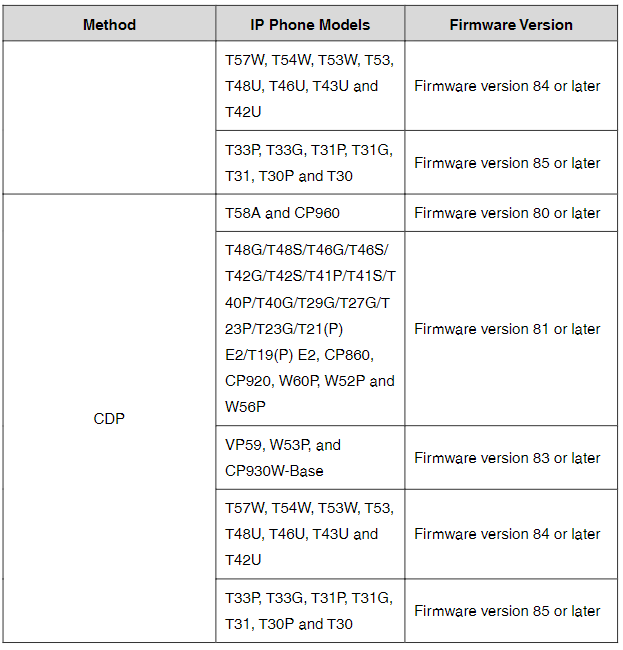VLAN-Option für IP-Telefon
Yealink -Telefon-VLAN-Funktion



VLANs bieten viele Vorteile, die in typischen LANs nicht vorhanden sind. Die wichtigsten Vorteile der Trennung von IP-Telefonen in VLAN(s) sind wie folgt:
Leistungsverbesserungen: VLAN wird verwendet, um die Broadcast-Domäne zu minimieren. Durch die Erstellung einer kleineren Domäne für IP- Telefon kann der Overhead reduziert und die Ressourcennutzung eingeschränkt werden. Darüber hinaus muss weniger Datenverkehr weitergeleitet werden und die durch Router verursachte Latenz wird reduziert.
Einfache Verwaltung: Durch den Einsatz von VLANs lassen sich viele Kosten für Netzwerkerweiterungen und -verlagerungen einsparen. IP- Telefon können von einer Arbeitsgruppe oder Abteilung in eine andere verschoben werden, ohne dass neue Netzwerkkabel installiert und Hubs oder Router neu konfiguriert werden müssen.
Sicherheit: VLANs können verwendet werden, um sichere Benutzergruppen zu erstellen und zu verhindern, dass andere außerhalb der Broadcast-Domäne vertrauliche Daten des IP- Telefon empfangen. Sie können auch verwendet werden, um Firewall-Funktionen zu verbessern und den Netzwerkzugriff für einen oder mehrere Benutzer einzuschränken. Durch die Trennung von IP-Telefonen in VLANs können Sicherheitsfilter im Netzwerk implementiert werden, um zu verhindern, dass die IP-Telefone unnötigen Datenverkehr von anderen Geräten empfangen. Dies hilft, Störungen durch DoS-Angriffe oder Versuche, die Geräte zu kompromittieren. Außerdem können Sie den Zugriff auf Konfiguration und Server sperren, sodass nur der Zugriff von IP-Telefonen aus möglich ist.
Es gibt vier Möglichkeiten, die VLAN-ID für den Internet-Port (WAN) zu erhalten, aber das verwendete VLAN wird anhand der Priorität jeder Methode (von der höchsten zur niedrigsten) ausgewählt: LLDP/CDP > Manuell > DHCPVLAN. Es gibt nur eine Möglichkeit, die VLAN-ID für den PC-Port zu erhalten: Manuell. Yealink SIP VP-T49G IP-Telefone unterstützen VLAN im drahtlosen Netzwerk. Die Methode, die die Telefone verwenden, um die VLAN-ID im drahtlosen Netzwerk zu erhalten, ist dieselbe wie im kabelgebundenen Netzwerk.
Notiz
LLDP- und CDP-Methoden haben dieselbe Priorität, um die VLAN-ID abzurufen. Normalerweise ist die VLAN-ID, die für das IP-Telefon mit LLDP- und CDP-Methoden abgerufen wird, dieselbe.
Die folgende Tabelle listet die von Yealink SIP IP-Telefonen mit verschiedenen Versionen unterstützten Methoden auf.


Automatische Erkennungsmethode für VLAN
LLDP-Einführung
LLDP (Link Layer Discovery Protocol) ermöglicht es IP-Telefonen, gerätebezogene Informationen an direkt verbundene Geräte im Netzwerk zu empfangen und/oder zu übertragen, die ebenfalls das Protokoll verwenden, und die Informationen zu speichern, die über andere Geräte gelernt werden. Mit LLDP gesammelte Informationen werden im Gerät als Management Information Database (MIB) gespeichert und können mit dem Simple Network Management Protocol (SNMP) gemäß RFC 2922 abgefragt werden. LLDP überträgt die Informationen als Pakete, die als LLDP Data Units (LLDPDUs) bezeichnet werden. Eine LLDPDU besteht aus einer Reihe von Type-Length-Value-Elementen (TLV), von denen jedes einen bestimmten Informationstyp über das Gerät oder den Port enthält, der es überträgt.
Jede der TLV-Komponenten hat die folgende Grundstruktur:

Obligatorische LLDP-TLVs: Chassis-ID, Port-ID und Time to Live (TTL) sind standardmäßig in einer LLDPDU enthalten.
Optionale LLDP-TLVs: Systemname, Systembeschreibung usw., das Telefon sendet die optionalen TLVs zusammen mit den obligatorischen TLVs in einer LLDPDU.
Organisationsspezifische TLVs: MAC/PHY-Konfiguration/Status und Port-VLAN-ID, die jeweils im IEEE-Standard 802.3 und 802.1 definiert sind. Der LLDP-Frame endet mit einem speziellen TLV namens „Ende der LLDPDU“, in dem sowohl das Typ- als auch das Längenfeld 0 sind.
LLDP-MED (Media Endpoint Discovery) wird von der Telecommunications Industry Association (TIA) veröffentlicht. Es handelt sich um eine Erweiterung von LLDP, die zwischen Endgeräten und Netzwerkkonnektivitätsgeräten funktioniert. LLDP-MED bietet insbesondere Unterstützung für Voice-over-IP-Anwendungen (VoIP) und stellt die folgenden Funktionen bereit:
Funktionenerkennung – ermöglicht LLDP-MED-Endpunkten, die Funktionen zu ermitteln, die das verbundene Gerät unterstützt und aktiviert hat. Damit kann angezeigt werden, ob es sich bei dem verbundenen Gerät um ein Telefon, einen Switch, einen Repeater usw. handelt.
Voice-VLAN-Konfiguration – bietet einen Mechanismus, mit dem ein Switch einem Gerät mitteilen kann, welches VLAN verwendet werden soll, wodurch „Plug-and-Play“-Netzwerke ermöglicht werden.
Energieverwaltung – bietet Informationen zur Stromversorgung des Geräts, zu den Energieprioritäten und zum Strombedarf des Geräts.
Bestandsverwaltung – bietet eine Möglichkeit zur Verwaltung des Geräts und seiner Attribute wie Modellnummer, Seriennummer, Softwarerevision usw.
Location Identification Discovery – übermittelt beim Tätigen eines Notrufs Standortinformationen vom Switch an das Gerät.
LLDP-MED-Funktionen TLV
Netzwerkrichtlinie TLV
Energieverwaltung TLV
Lagerbestandsführung TLV
Standortidentifikation TLV (wird von IP-Telefonen nicht unterstützt)
Es ist zu beachten, dass entweder LLDP oder LLDP-MED – aber nicht beide – gleichzeitig auf einer Schnittstelle zwischen zwei Geräten verwendet werden können.
LLDP bietet außergewöhnliche Vorteile bei der Interoperabilität, Fehlerbehebung bei IP-Telefonie, automatische Bereitstellung von Richtlinien und erweitertes PoE (Power over Ethernet). Wenn die LLDP-Funktion auf IP-Telefonen aktiviert ist, geben die IP-Telefone regelmäßig ihre eigenen Informationen an den direkt angeschlossenen LLDP-fähigen Switch weiter. Die IP-Telefone können auch LLDP-Pakete vom angeschlossenen Switch empfangen. Wenn der Anwendungstyp „Sprache“ ist, entscheiden IP-Telefone, ob die aus den LLDP-Paketen erhaltenen VLAN-Konfigurationen aktualisiert werden sollen. Wenn sich die VLAN-Konfigurationen auf den IP-Telefonen von denen unterscheiden, die vom Switch gesendet wurden, führen die IP-Telefone ein Update durch und starten neu. Dadurch können die IP-Telefone an jeden Switch angeschlossen werden, ihre VLAN-IDs abrufen und dann die Kommunikation mit der Anrufsteuerung starten.
Unterstützte TLVs von IP-Telefonen
Von IP-Telefonen unterstützte TLVs sind in der folgenden Tabelle zusammengefasst:
...
PDF herunterladen: Klicken Sie hier >

Cost-effective Wi-Fi IP Phone Solution

Wireless coverage range of about 50m indoors and up to 300m outdoors

Professional ruggedized phone system for challenging environments

Elite desktop phone for executives and professionals

HD IP Conference Phone for on-the-go needs and huddle rooms

Well-rounded Office Phone & Cost-effective WiFi IP phone
Contact Us
Contact us for product quotes and installation consultations. We will promptly notify a local dealer to provide you with accurate and efficient service solutions.







